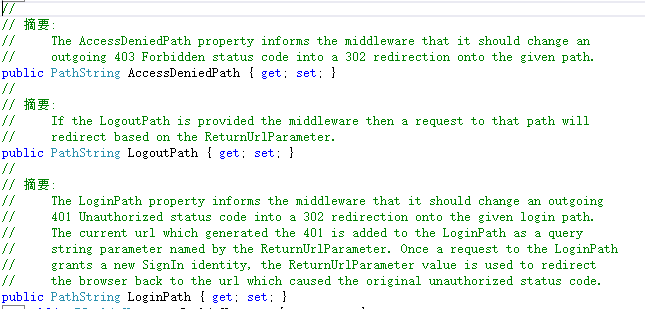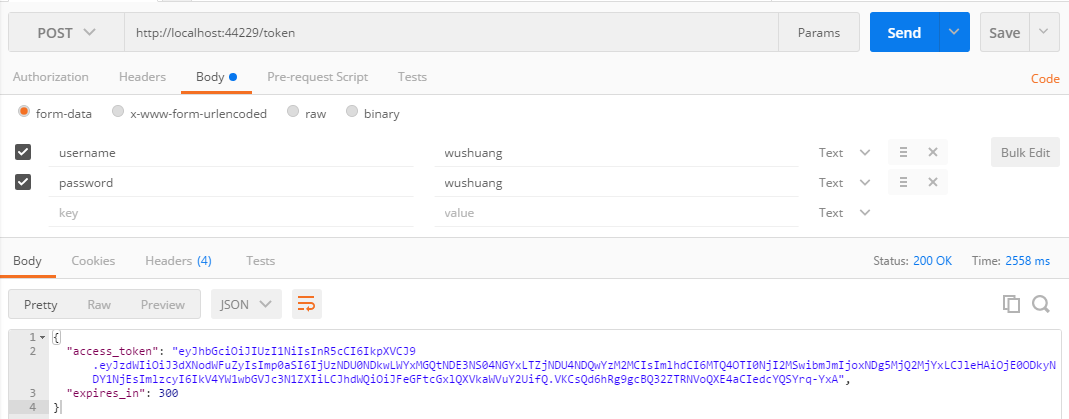Asp.Net Core Authentication Middleware And Generate Token

写在前面
本文版权归博客园和作者吴双本人共同所有 转载和爬虫请注明原文地址 cnblogs.com/tdws
After using OWIN for months for basic OAuth authentication, it’s apparent that Microsoft is abandoning OWIN . This isn’t necessarily a bad thing. .NET Core is built on a similar structure as that which was implemented in OWIN. Essentially, we have a familiar middleware pipeline.
这句话出自老外的博客,在使用Owin的OAuth身份认证几个月后,发现微软在逐渐放弃OWIN,这未必是一件坏事情,.NET Core在一个和OWIN所实现的相似结构之上。我们有一个和OWIN极为相似的中间件管道。
想必了解或者使用过OWIN的朋友们,在做.NET Core应用的时候都会有如上描述的这种感觉。就我个人的理解,微软在早几年推出OWIN的时候,就希望将管道留给用户,就以Startup.cs为管道配置和应用入口,OWIN脱离了Asp.Net管道事件,我们可以将任何中间件在管道中随意插拔。在OWIN中为我们提供了完备的认证流程,和一套完整的规范。比如 Microsoft.Owin.Security.OAuth等,在使用OWIN时,我们可以使用OWIN的默认实现,也可以实现其接口,自定义我们自己的实现方式。有关Microsoft OWIN的内容,不是本篇分享的主题,推荐腾飞的MVC5 - ASP.NET Identity登录原理 - Claims-based认证和OWIN 和蟋蟀哥的 ASP.NET WebApi OWIN 实现 OAuth 2.0 。
Token
本篇分享主要关注在.NET Core的认证机制。无论我们是使用WebApi还是MvcWeb App,了解微软的认证机制总是有好处的。认证是应用API服务器识别用户身份的过程,token是更现代的认证方式,简化权限管理,降低服务器负载。在认证过程中,最重要的就是拿到token, token包含或者应该包含什么信息呢?
1.这个人是谁?
2.这个人可以用此token访问什么样的内容?(scope)
3.token的过期时间 (expire)
4.谁发行的token。
5.其他任何你希望加入的声明(Claims)
那我们为什么要使用token呢?使用session或者用redis来实现stateServer不好吗?
1.token是低(无)状态的,Statelessness
2.token可以与移动端应用紧密结合
3.支持多平台服务器和分布式微服务
拿到token后如何带入HTTP请求传给后台?
答案是两种方式,Cookies和Authorization Header。那么什么时候放到Cookies中,什么时候又放到Authentication中呢?
第一,如果是在Web应用,则放到Cookies当中,并且应该是HttpOnly的,js不能直接对其进行操作,安全性会比将其存在Web Stroage中好一些,因为在Web Storage当中的内容,可以很容的被潜在的XSS脚本攻击并获取。在HttpOnly的cookies当中会相对安全一些,不过也有潜在的CSRF跨站伪造请求的危险,不过这种hack的手段成功率是很低的,有兴趣的朋友可以自行看一下CSRF原理。
第二,如果是手机移动端应用的话,那一定是存储在App本地,并由Authorization Header带到后台并得到身份认证。
WebApp Cookies Authentication
上一段前两周写的最原始的小Demo吧,没有数据库访问等,可根据demo自行改变 ,现在的新代码已经加入了很多业务在其中
startup.cs代码
- using Microsoft.AspNetCore.Authentication.Cookies;
- using Microsoft.AspNetCore.Builder;
- using Microsoft.AspNetCore.Hosting;
- using Microsoft.AspNetCore.Http;
- using Microsoft.AspNetCore.Http.Authentication;
- using Microsoft.Extensions.Configuration;
- using Microsoft.Extensions.DependencyInjection;
- using Microsoft.Extensions.Logging;
- using System.Collections.Generic;
- using System.Security.Claims;
- using Wings.AuthenticationApp.Middleware;
- namespace Wings.AuthenticationApp
- {
- public class Startup
- {
- public Startup(IHostingEnvironment env)
- {
- var builder = new ConfigurationBuilder()
- .SetBasePath(env.ContentRootPath)
- .AddJsonFile("appsettings.json", optional: false, reloadOnChange: true)
- .AddJsonFile($"appsettings.{env.EnvironmentName}.json", optional: true)
- .AddEnvironmentVariables();
- Configuration = builder.Build();
- }
- public IConfigurationRoot Configuration { get; }
- // This method gets called by the runtime. Use this method to add services to the container.
- public void ConfigureServices(IServiceCollection services)
- {
- // Add framework services.
- services.AddMvc();
- }
- // This method gets called by the runtime. Use this method to configure the HTTP request pipeline.
- public void Configure(IApplicationBuilder app, IHostingEnvironment env, ILoggerFactory loggerFactory)
- {
- loggerFactory.AddConsole(Configuration.GetSection("Logging"));
- loggerFactory.AddDebug();
- app.UseCookieAuthentication(CookieAuthMiddleware.GetOptions());
- app.UseOwin();
- app.UseCors(a => { a.AllowAnyOrigin(); });
- app.UseMvc();
- // Listen for login and logout requests
- app.Map("/login", builder =>
- {
- builder.Run(async context =>
- {
- var name = context.Request.Form["name"];
- var pwd = context.Request.Form["pwd"];
- if (name == "wushuang" && pwd == "wushuang")
- {
- var claims = new List<Claim>() { new Claim("name", name), new Claim("role", "admin") };
- var identity = new ClaimsIdentity(claims, "password");
- var principal = new ClaimsPrincipal(identity);
- await context.Authentication.SignInAsync(CookieAuthenticationDefaults.AuthenticationScheme, principal);
- context.Response.Redirect("http://www.baidu.com");
- }
- else
- {
- await context.Authentication.SignOutAsync(CookieAuthenticationDefaults.AuthenticationScheme);
- context.Response.Redirect("http://www.google.com");
- }
- });
- });
- //app.Map("/logout", builder =>
- //{
- // builder.Run(async context =>
- // {
- // // Sign the user out / clear the auth cookie
- // await context.Authentication.SignOutAsync(CookieAuthenticationDefaults.AuthenticationScheme);
- // // Perform a simple redirect after logout
- // context.Response.Redirect("/");
- // });
- //});
- }
- }
- }
下面是Middleware---->CookieAuthMiddleware.cs的代码,
- using Microsoft.AspNetCore.Authentication.Cookies;
- using Microsoft.AspNetCore.Builder;
- using Microsoft.AspNetCore.Http;
- using System;
- using System.Collections.Generic;
- using System.Linq;
- using System.Security.Claims;
- using System.Security.Principal;
- using System.Threading.Tasks;
- namespace Wings.AuthenticationApp.Middleware
- {
- public class CookieAuthMiddleware
- {
- public static CookieAuthenticationOptions GetOptions()
- {
- return new CookieAuthenticationOptions
- {
- AutomaticAuthenticate = true,
- AutomaticChallenge = true,
- LoginPath = new PathString("/login"),
- LogoutPath = new PathString("/logout"),
- AccessDeniedPath = new PathString("/test"),
- CookieHttpOnly = false, //默认就是True了
- CookieName = "wings_access_token",
- SlidingExpiration = true,
- CookieManager = new ChunkingCookieManager()
- };
- }
- }
- public static class IdentityExtension
- {
- public static string FullName(this IIdentity identity)
- {
- var claim = ((ClaimsIdentity)identity).FindFirst("name");
- return (claim != null) ? claim.Value : string.Empty;
- }
- public static string Role(this IIdentity identity)
- {
- var claim = ((ClaimsIdentity)identity).FindFirst("role");
- return (claim != null) ? claim.Value : string.Empty;
- }
- }
- }
对应如上demo,简单测试一下,结果如下:

首先使用错误的密码,来请求token endpoint,接下来我们看一下即使窗口,当有请求进入的时候,我用如下代码判断用户的认证情况,拿到的结果必然是false:

接下来,我使用正确的账号密码,来打入token,判断结果一定为true,所以我使用自定义的拓展方法,来获取下,该用户token的信息:

如上demo没有加入一些容错机制,请注意。在用户认证成功后,可以进入带有Authorize Attribute的Action,否则401.如下是几个重要参数的解释

自定义Authentication Middle生产Token
Startup.cs
- using System;
- using System.Collections.Generic;
- using System.Linq;
- using System.Threading.Tasks;
- using Microsoft.AspNetCore.Builder;
- using Microsoft.AspNetCore.Hosting;
- using Microsoft.Extensions.Configuration;
- using Microsoft.Extensions.DependencyInjection;
- using Microsoft.Extensions.Logging;
- using Wings.TokenAuth.Middleware;
- using System.Security.Claims;
- using Microsoft.IdentityModel.Tokens;
- using System.Text;
- using Microsoft.Extensions.Options;
- namespace Wings.TokenAuth
- {
- public class Startup
- {
- public Startup(IHostingEnvironment env)
- {
- var builder = new ConfigurationBuilder()
- .SetBasePath(env.ContentRootPath)
- .AddJsonFile("appsettings.json", optional: false, reloadOnChange: true)
- .AddJsonFile($"appsettings.{env.EnvironmentName}.json", optional: true)
- .AddEnvironmentVariables();
- Configuration = builder.Build();
- }
- public IConfigurationRoot Configuration { get; }
- // This method gets called by the runtime. Use this method to add services to the container.
- public void ConfigureServices(IServiceCollection services)
- {
- // Add framework services.
- services.AddMvc();
- }
- // The secret key every token will be signed with.
- // In production, you should store this securely in environment variables
- // or a key management tool. Don't hardcode this into your application!
- private static readonly string secretKey = "mysupersecret_secretkey!123";
- public void Configure(IApplicationBuilder app, IHostingEnvironment env, ILoggerFactory loggerFactory)
- {
- loggerFactory.AddConsole(LogLevel.Debug);
- loggerFactory.AddDebug();
- app.UseStaticFiles();
- // Add JWT generation endpoint:
- var signingKey = new SymmetricSecurityKey(Encoding.ASCII.GetBytes(secretKey));
- var options = new TokenProviderOptions
- {
- Audience = "ExampleAudience",
- Issuer = "ExampleIssuer",
- SigningCredentials = new SigningCredentials(signingKey, SecurityAlgorithms.HmacSha256),
- };
- app.UseMiddleware<TokenProviderMiddleware>(Options.Create(options));
- app.UseMvc();
- }
- }
- }
TokenProviderOptions.cs
- using Microsoft.AspNetCore.Http;
- using Microsoft.Extensions.Options;
- using Microsoft.IdentityModel.Tokens;
- using Newtonsoft.Json;
- using System;
- using System.Collections.Generic;
- using System.IdentityModel.Tokens.Jwt;
- using System.Linq;
- using System.Security.Claims;
- using System.Threading.Tasks;
- namespace Wings.TokenAuth.Middleware
- {
- public class TokenProviderOptions
- {
- public string Path { get; set; } = "/token";
- public string Issuer { get; set; }
- public string Audience { get; set; }
- public TimeSpan Expiration { get; set; } = TimeSpan.FromMinutes();
- public SigningCredentials SigningCredentials { get; set; }
- }
- public class TokenProviderMiddleware
- {
- private readonly RequestDelegate _next;
- private readonly TokenProviderOptions _options;
- public TokenProviderMiddleware(
- RequestDelegate next,
- IOptions<TokenProviderOptions> options)
- {
- _next = next;
- _options = options.Value;
- }
- public Task Invoke(HttpContext context)
- {
- // If the request path doesn't match, skip
- if (!context.Request.Path.Equals(_options.Path, StringComparison.Ordinal))
- {
//use new JwtSecurityTokenHandler().ValidateToken() to valid token- return _next(context);
- }
- // Request must be POST with Content-Type: application/x-www-form-urlencoded
- if (!context.Request.Method.Equals("POST")
- || !context.Request.HasFormContentType)
- {
- context.Response.StatusCode = ;
- return context.Response.WriteAsync("Bad request.");
- }
- return GenerateToken(context);
- }
- private async Task GenerateToken(HttpContext context)
- {
- var username = context.Request.Form["username"];
- var password = context.Request.Form["password"];
- var identity = await GetIdentity(username, password);
- if (identity == null)
- {
- context.Response.StatusCode = ;
- await context.Response.WriteAsync("Invalid username or password.");
- return;
- }
- var now = DateTime.UtcNow;
- // Specifically add the jti (random nonce), iat (issued timestamp), and sub (subject/user) claims.
- // You can add other claims here, if you want:
- var claims = new Claim[]
- {
- new Claim(JwtRegisteredClaimNames.Sub, username),
- new Claim(JwtRegisteredClaimNames.Jti, Guid.NewGuid().ToString()),
- new Claim(JwtRegisteredClaimNames.Iat, ToUnixEpochDate(now).ToString(), ClaimValueTypes.Integer64)
- };
- // Create the JWT and write it to a string
- var jwt = new JwtSecurityToken(
- issuer: _options.Issuer,
- audience: _options.Audience,
- claims: claims,
- notBefore: now,
- expires: now.Add(_options.Expiration),
- signingCredentials: _options.SigningCredentials);
- var encodedJwt = new JwtSecurityTokenHandler().WriteToken(jwt);
- var response = new
- {
- access_token = encodedJwt,
- expires_in = (int)_options.Expiration.TotalSeconds
- };
- // Serialize and return the response
- context.Response.ContentType = "application/json";
- await context.Response.WriteAsync(JsonConvert.SerializeObject(response, new JsonSerializerSettings { Formatting = Formatting.Indented }));
- }
- private Task<ClaimsIdentity> GetIdentity(string username, string password)
- {
- // DON'T do this in production, obviously!
- if (username == "wushuang" && password == "wushuang")
- {
- return Task.FromResult(new ClaimsIdentity(new System.Security.Principal.GenericIdentity(username, "Token"), new Claim[] { }));
- }
- // Credentials are invalid, or account doesn't exist
- return Task.FromResult<ClaimsIdentity>(null);
- }
- public static long ToUnixEpochDate(DateTime date)
- => (long)Math.Round((date.ToUniversalTime() - new DateTimeOffset(, , , , , , TimeSpan.Zero)).TotalSeconds);
- }
- }
下面上测试结果:
使用错误的账户和密码请求token

使用正确的账户和密码来请求,返回结果如下:

如果,您认为阅读这篇博客让您有些收获,不妨点击一下右下加【推荐】按钮。
如果,您希望更容易地发现我的新博客,不妨点击下方红色【关注】的。
因为,我的分享热情也离不开您的肯定支持。
感谢您的阅读,我将持续输出分享,我是蜗牛, 保持学习,谨记谦虚。不端不装,有趣有梦。
参考文章和论文,不仅限于如下几篇,感谢国外大佬们有深度的分享:
http://stackoverflow.com/questions/29055477/oauth-authorization-service-in-asp-net-core
https://stormpath.com/blog/token-authentication-asp-net-core
https://docs.microsoft.com/en-us/aspnet/core/fundamentals/middleware#fundamentals-middleware
https://docs.microsoft.com/en-us/aspnet/core/security/authentication/cookie#controlling-cookie-options
https://stormpath.com/blog/token-authentication-asp-net-core
Asp.Net Core Authentication Middleware And Generate Token的更多相关文章
- ASP.NET Core Authentication系列(二)实现认证、登录和注销
前言 在上一篇文章介绍ASP.NET Core Authentication的三个重要概念,分别是Claim, ClaimsIdentity, ClaimsPrincipal,以及claims-bas ...
- ASP.NET Core 实战:基于 Jwt Token 的权限控制全揭露
一.前言 在涉及到后端项目的开发中,如何实现对于用户权限的管控是需要我们首先考虑的,在实际开发过程中,我们可能会运用一些已经成熟的解决方案帮助我们实现这一功能,而在 Grapefruit.VuCore ...
- 在ASP.NET Core使用Middleware模拟Custom Error Page功能
一.使用场景 在传统的ASP.NET MVC中,我们可以使用HandleErrorAttribute特性来具体指定如何处理Action抛出的异常.只要某个Action设置了HandleErrorAtt ...
- ASP.NET Core中间件(Middleware)实现WCF SOAP服务端解析
ASP.NET Core中间件(Middleware)进阶学习实现SOAP 解析. 本篇将介绍实现ASP.NET Core SOAP服务端解析,而不是ASP.NET Core整个WCF host. 因 ...
- 利用Asp.Net Core的MiddleWare思想处理复杂业务流程
最近利用Asp.Net Core 的MiddleWare思想对公司的古老代码进行重构,在这里把我的设计思路分享出来,希望对大家处理复杂的流程业务能有所帮助. 背景 一个流程初始化接口,接口中根据传入的 ...
- ASP.NET Core中Middleware的使用
https://www.cnblogs.com/shenba/p/6361311.html ASP.NET 5中Middleware的基本用法 在ASP.NET 5里面引入了OWIN的概念,大致意 ...
- [转]在ASP.NET Core使用Middleware模拟Custom Error Page功能
本文转自:http://www.cnblogs.com/maxzhang1985/p/5974429.html 阅读目录 一.使用场景 二..NET Core实现 三.源代码 回到目录 一.使用场景 ...
- ASP.NET Core WebApi基于Redis实现Token接口安全认证
一.课程介绍 明人不说暗话,跟着阿笨一起玩WebApi!开发提供数据的WebApi服务,最重要的是数据的安全性.那么对于我们来说,如何确保数据的安全将会是需要思考的问题.在ASP.NET WebSer ...
- ASP.NET Core Authentication系列(四)基于Cookie实现多应用间单点登录(SSO)
前言 本系列前三篇文章分别从ASP.NET Core认证的三个重要概念,到如何实现最简单的登录.注销和认证,再到如何配置Cookie 选项,来介绍如何使用ASP.NET Core认证.感兴趣的可以了解 ...
随机推荐
- CentOS7 部署 tomcat
1. 准备tomcat账号 本着最小权限原则,新建账号来安装tomcat. 命令:useradd , passwd 2. 配置防火墙 2.1. tomcat.xml 在/etc/firewalld/s ...
- HDU1848-Fibonacci again and again
题目链接 http://acm.hdu.edu.cn/showproblem.php?pid=1848 这个题目代码不是很复杂,但那个等价类,(SG函数)没怎么理解, 题目难,不过代码不怎么复杂,在网 ...
- IOS拒绝Adobe的六大理由
苹果与Adobe的关系由来已久.事实上,Adobe的创始人还在他们众所周知的小车库里时,我们就碰过面了.苹果是他们的第一个大客户.我们将他们的Postscript语言应用于当时最新的Laserwrit ...
- 开源OSS.Social微信项目解析
前言:OSS.Social是个开源的社交网站接口集成项目,当前也有很多其他不错的项目,不过始终没有我想要的那种简单清晰,只能撸起袖子,从头打造一个.当前正在进行的是对微信项目的开发,这里把对接口的整 ...
- 《JAVASCRIPT高级程序设计》第一章
在使用调制解调器的时代,频繁的表单验证对客户端来说是一个很大的负担,javascript,作为一种专门进行表单验证的客户端脚本语言诞生了.到今天,javascript早已超越了当初设定的角色.Java ...
- HUST 1586 数字排列
1586 - 数字排列 时间限制:1秒 内存限制:128兆 91 次提交 36 次通过 题目描述 现有n个k位的数字,你的任务是重新安排数字每一位的位置,使得重新安排后这n个数字中最大的数字和最小的数 ...
- CSS Flexbox 学习指南、工具与框架
Flexbox 是一种更有效的布局方式,它能更好的分配容器空间,并控制项目的对齐.虽然,掌握它的理论有些复杂,但幸运的是,我们可以借助开放的网络来学习并逐步掌握它. 在本文中,我们整合了一些最佳的 F ...
- node-webkit制作桌面应用
心血来潮突然想用js尝试写桌面应用,突然发现我大js真的无所不能.在网上搜到了这么一个东东:node-webkit.用Node.js来进行系统资源的访问,用HTML+CSS完成页面的搭建.哇,一切突然 ...
- SQLServer 数据的导入
选择数据源,选择文件路径 直接点击下一步,选择自己的源表和目标表 勾选忽略,然后到完成,数据上传成功 可能出现的问题:源文件和目标文件的列名不一致,导致被忽略不能导入 预览发现有乱码,因为编码格式
- iOS开发——设计模式那点事
单例模式(Singleton) 概念:整个应用或系统只能有该类的一个实例 在iOS开发我们经常碰到只需要某类一个实例的情况,最常见的莫过于对硬件参数的访问类,比如UIAccelerometer.这个类 ...
